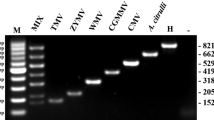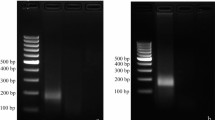Abstract
Viroids are the smallest known infectious pathogens. They are nonprotein-encoding, single-stranded, circular, naked RNA molecules that can cause several diseases in economically important crops. With the advent of thermal cyclers incorporating fluorescent detection, reverse transcription coupled to the quantitative polymerase chain reaction (RT-qPCR) has transformed the way the viroids are detected. The method involves using sequence-specific primers that anneal to the viroid RNA of interest. The viroid RNA serves as a template during reverse transcription, in which the enzyme reverse transcriptase generates a cDNA copy of a portion of the target RNA molecule. After first-strand cDNA synthesis, RNA template from cDNA:RNA hybrid molecule is removed by digestion with RNase H to improve the sensitivity of PCR step. This cDNA is then be used as a template for amplification of viroid sequence in PCR.
Access this chapter
Tax calculation will be finalised at checkout
Purchases are for personal use only
Similar content being viewed by others
References
Semancik JS, Weathers LG (1972) Exocortis virus: an infectious free-nucleic acid plant virus with unusual properties. Virology 46:456–466
Semancik JS, Morris TJ, Weathers LG, Rordorf GF, Kearns DR (1975) Physical properties of a minimal infectious RNA (viroid) associated with the exocortis disease. Virology 63(1):160–167
Mackay IM, Arden KE, Nitsche A (2002) Real-time PCR in virology. Nucleic Acids Res 30(6):1292–1305
Hajeri S, Ramadugu C, Manjunath K, Ng J, Lee R, Vidalakis G (2011) In vivo generated citrus exocortis viroid progeny variants display a range of phenotypes with altered levels of replication, systemic accumulation and pathogenicity. Virology 417:400–409
Loconsole G, Önelge N, Yokomi RK, Kubaa RA, Savino V, Saponari M (2013) Rapid differentiation of citrus hop stunt viroid variants by real-time RT-PCR and high resolution melting analysis. Mol Cell Probes 27(5–6):221–229
Roistacher CN, Calavan EC, Blue RL, Navarro L, Gonzales R (1977) A new more sensitive citron indicator for detection of mild isolates of citrus exocortis viroid (CEV). Plant Dis Rep 61:135–139
Semancik JS, Roistacher CN, Rivera-Bustamante R, Duran-Vila N (1988) Citrus cachexia viroid, a new viroid of citrus: relationship to viroids of the exocortis disease complex. J Gen Virol 69:3059–3068
Roistacher CN (1991) Techniques for biological detection of specific citrus graft-transmissible diseases. In: Roistacher CN (ed) In: graft-transmissible diseases of citrus: handbook for detection and diagnosis. International Organization of Citrus Virologists and Food and Agricultural Organization of the United Nations, Rome, pp 13–151
Hajeri (2010) ‘Study of molecular and biological properties of citrus exocortis viroid and Dweet mottle virus’ Doctoral dissertation, University of California, Riverside
Acknowledgments
This work was supported in part by USDA Agricultural Research Service, In-House Appropriated Project Number 2034-22000-013-00-D, California Department of Food and Agriculture Specialty Crops Block Grant SCB10005, California Citrus Nursery Board Yok-13, and the California Citrus Research Board. Mention of trade names or commercial products in this publication is solely for the purpose of providing specific information and does not imply recommendation or endorsement by the US Department of Agriculture.
Author information
Authors and Affiliations
Corresponding authors
Editor information
Editors and Affiliations
Rights and permissions
Copyright information
© 2022 Springer Science+Business Media, LLC, part of Springer Nature
About this protocol
Cite this protocol
Hajeri, S., Vidalakis, G., Yokomi, R.K. (2022). Detection of Viroids Using RT-qPCR. In: Rao, A.L.N., Lavagi-Craddock, I., Vidalakis, G. (eds) Viroids. Methods in Molecular Biology, vol 2316. Humana, New York, NY. https://doi.org/10.1007/978-1-0716-1464-8_14
Download citation
DOI: https://doi.org/10.1007/978-1-0716-1464-8_14
Published:
Publisher Name: Humana, New York, NY
Print ISBN: 978-1-0716-1463-1
Online ISBN: 978-1-0716-1464-8
eBook Packages: Springer Protocols




